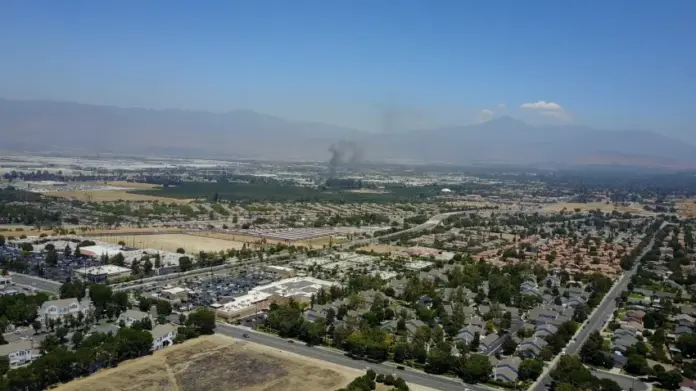Most Polluted Cities in North America: Air pollution is one of the global environmental issues that poses life-threatening effects on the world. Moreover, just like other countries, the US also has many such states and cities that are performing poorly in the race to reduce pollution. The air quality index is calculated to check the air pollution in an area and its severity. The higher the value of the Air Quality Index, the more pollution in the area. Other than that, particulate matter is also a widely used indicator that shows the pollutants present in the atmosphere.
However, the Air Quality Index is not the main concern of Air pollution; it exposes humans and all other living organisms to the risk to their lives. It is caused when harmful substances are left in the air without proper treatment, including particulate matter, excess CO2, and CO. They pose several health risks not only to humans but also to animals and birds, including respiratory issues like asthma or
Let us look at the top 10 polluted cities in North America in detail and understand the factors that contributed to their present condition.
10 Top Polluted Cities in North America (including US)
1. Ontario, California
Ontario is the most polluted city in North America, according to the latest updates in the Air Quality Index. It has an Air Quality Index of approximately 240, which is considered unhealthy per the metrics. The main reasons for such a high AQI in this city are the high vehicular emissions, untreated industrial releases, and trapped pollutants in the air. Due to this, the public is exposed to health risks such as respiratory issues and cardiovascular diseases that decrease their productivity.
Also read: 10 Most Dangerous Neighborhoods in Houston (2024 Crime Report)
2. Bloomington, California
Bloomington is just a step below Ontario in terms of the Air Quality Index among all cities in North America. It has observed an Air Quality Index of approximately 230, which is also considered unhealthy in the AQI metrics. The main reasons for the high AQI in Bloomington are the city’s heavy traffic area and proximity to the industrial areas, which significantly affect the air quality of the area. Such a high exposure to pollution in the city leads to several health risks, such as asthma and other respiratory issues, for the public.
3. Huntington Park, California
With an overall AQI of 220 for the year, Huntington makes it to third place for the most polluted cities in North America. The pollutant PM2.5 is 13.6 𝛍g/m³, which shows the pollution level of the city irrespective of the daily AQI. The main reason for the high pollution level in the city is its densely populated area, vehicular emissions, and proximity to industrial areas. The major drawback of this condition is for the lower-income groups who cannot afford to get proper treatment.
4. San Bernardino, California
According to the pollutant PM2.5 present in the air, San Bernardino has secured its place as the fourth most polluted city in North America. The value of PM2.5 in the air is 12.9 𝛍g/m³, which shows the extreme pollution level in the city. The major reason for the high pollution level is that the city is surrounded by hills that act like a trapping machine for pollutants. Other than that, we can say that it shows a constant dropping level of air quality and increased ozone and particulate matter in the air.
5. Fontana, California
Fontana holds a PM2.5 value of 12.7 𝛍g/m³ in the air due to excessive use of diesel and expansion of logistics and warehouse operations in the city. This makes Fontana the fifth most polluted city in North America, which is trying to bring the levels down. The city has tried to apply the alternatives, such as clean freight; however, they are still slow in adapting.
6. Visalia, California
This city has a PM2.5 value of 12.5 𝛍g/m³ in the air, which makes it the sixth number in most polluted city in North America. Moreover, the major reason for high pollution in the city is its agricultural methods, which expose the air to fine dust particles, and the yearly wildfires that occur in its forests. The city is mostly found in the worst pollution conditions in two seasons- summer and fall.
Also read: Top 10 Affordable Overwater Bungalows to Book in 2025
7. Mission, Texas
Texas is one of the fastest-developing cities in North America, but it is lagging in the matter of reducing pollution levels. Its city, Mission has a PM2.5 value of 12.4 𝛍g/m³, which makes it among the top 10 polluted cities in North America. The major reasons for such pollution levels include its proximity to industrial areas, agricultural waste burning, and truck traffic in the city. The main impact of the deteriorating air quality is directly on the Rio Grande Valley, where the environment is unstable. Other than that, the public is also facing issues in breathing and even some fatal respiratory issues.
8. Glendora, California
Glendora is a city surrounded by hills, which traps pollutants inside the city region and exposes the people to high pollution levels. The city has a PM2.5 level of 12.3 𝛍g/m³, which makes it one of the top 10 polluted cities in North America. Moreover, the freeways are not given much space, causing heavy traffic, wood is burnt, and constant wildfires break out, which directly impact the air quality.
9. Hanford, California
Hanford is prone to extreme weather conditions, such as dust storms that add a lot of matter into the atmosphere. Moreover, with a PM2.5 level of 12.2 𝛍g/m³, the city is focused on agriculture and waste burning, which is a contributing factor in the rise of pollution levels. Other than this, the city is also given unhealthy air quality alerts frequently by the authorities.
10. Conroe, Texas
Conroe has a PM2.5 level of 12.0 𝛍g/m³, which makes it a city with a high pollution level and a recipient of this list. Due to its proximity to Houston and its industrial areas, Conroe faces a high pollution level throughout the year. In addition, the area has observed an increase in vehicular use, causing the release of emissions into the air. The city also has an absence of sufficient public transport, which makes people dependent on their private vehicles.
AQI Scale and Health Risks
The Air Quality Index shows the air quality in a particular region and is used to determine the risk of health complications due to deteriorating air quality. The scale through which we conclude the complexity of the AQI is mentioned below:
- 0-50: considered good
- 51-100: considered moderate
- 101-150: considered unhealthy for sensitive groups in society
- 151-200: considered unhealthy
- 201-300: considered very unhealthy
- 301 and above: considered hazardous
The short-term indications of poor air quality in your area include irritation of the eyes, nose, and throat, along with signs of coughing and breathing difficulties. If we talk about the long-term effects of exposure to pollution, it may turn into complex health issues like respiratory and cardiovascular diseases, and also the worsening of existing health problems.
Also read: Best Time to Visit Japan & 10 Must-Visit Places | Japan Travel Guide 2025
Conclusion
This situation has come forward due to our negligence of nature when it screamed preservation. However, we can still save ourselves from its aggression in the future if we unite and preserve the environment. In the cities, industrial emissions and vehicular emissions are the main causes of pollution, whereas in rural areas, agricultural burning is the major cause of the same. The city authorities must take preservation measures to reduce the high level of pollution in the environment. On the other hand, people are advised to use public transport so that vehicular emissions can be reduced in the area, and carry masks to avoid unnecessary pollutants from entering their bodies. Moreover, working together is a necessity to save Mother Earth from destruction and to pass on a healthy environment to future generations.








